
The New York Times may deny that it’s playing the BuzzFeed game, but there’s no getting around the fact that with the homepage declining in importance as a source of publishers’ traffic, the pressure to use social media to find readers has never been greater.
Accordingly, this trend is creating some anxiety on the people on the front lines. A survey of 250 journalists by Edelman Berland and Muck Rack revealed that more than three-quarters of them feel pressure about getting their stories shared on social media.
The rise of social media is changing the way reporters approach their stories, too. Images are the most-used tactic to make stories more sharable, used by 82 percent of survey respondents. They’re also writing stories about topics that are already trending, writing shorter stories and using numbers in headlines or listicles.
This shift is happening as their employers are becoming increasingly dependent on social media for traffic. In September 2013, the eight biggest social referrers drove 16.4 percent of traffic to publishers’ sites, according to Shareaholic, which measured traffic across more than 200 sites of varying audience sizes. A year later, that number had nearly doubled, to 29.5 percent. Facebook is in a class all its own: It drove more than 22 percent of referrals to publishers, with Pinterest a distant second.
The sites that are winning on Facebook are digital-native, viral sites, led by The Huffington Post, which had more than 42 million total likes, shares and comments in December.
The HuffPost got the most engagements for the month of December (the top 5 most-shared sites were consistent with the prior two months), but when it came to efficiency, PlayBuzz was by far the most productive. Not only does most of its content come from its users, but the viral site has mastered the art of lists and quizzes such that each of its 1,145 posts in December averaged more than 21,000 likes, shares or comments.
Twitter, meanwhile, favored news publishers, according to NewsWhip’s analysis. The BBC was the most-tweeted site in December, with nearly 3.8 million tweets. Moreover, seven of the 10 most-tweeted sites were established outlets in December, a list that was fairly consistent over the previous two months. Twitter’s overall reach is much smaller than Facebook’s, though.
More in Media

Publishers are hunting for AI prompt data — now they’re starting to get it from third-party companies
Publishers are finally gaining some visibility into AI search, as new prompt data tools crack open a black box.

Digiday+ Research: Publishers’ growing focus on video doesn’t translate to social platforms
Major publishers have made recent investments in vertical video, but that shift is not carrying over to social media platforms.

Technology x humanity: A conversation with Dayforce’s Amy Capellanti-Wolf
Capellanti-Wolf shared insight on everything from navigating AI adoption and combating burnout to rethinking talent strategies.





